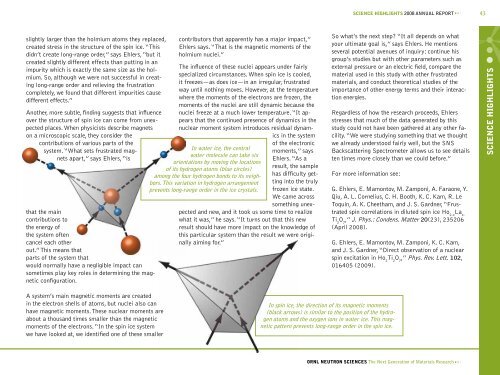Neutron Sciences 2008 Annual Report - 17.79 MB - Spallation ...
Neutron Sciences 2008 Annual Report - 17.79 MB - Spallation ...
Neutron Sciences 2008 Annual Report - 17.79 MB - Spallation ...
You also want an ePaper? Increase the reach of your titles
YUMPU automatically turns print PDFs into web optimized ePapers that Google loves.
slightly larger than the holmium atoms they replaced,<br />
created stress in the structure of the spin ice. “This<br />
didn’t create long-range order,” says Ehlers, “but it<br />
created slightly different effects than putting in an<br />
impurity which is exactly the same size as the holmium.<br />
So, although we were not successful in creating<br />
long-range order and relieving the frustration<br />
completely, we found that different impurities cause<br />
different effects.”<br />
Another, more subtle, finding suggests that influence<br />
over the structure of spin ice can come from unexpected<br />
places. When physicists describe magnets<br />
on a microscopic scale, they consider the<br />
contributions of various parts of the<br />
system. “What sets frustrated magnets<br />
apart,” says Ehlers, “is<br />
that the main<br />
contributions to<br />
the energy of<br />
the system often<br />
cancel each other<br />
out.” This means that<br />
parts of the system that<br />
would normally have a negligible impact can<br />
sometimes play key roles in determining the magnetic<br />
configuration.<br />
A system’s main magnetic moments are created<br />
in the electron shells of atoms, but nuclei also can<br />
have magnetic moments. These nuclear moments are<br />
about a thousand times smaller than the magnetic<br />
moments of the electrons. “In the spin ice system<br />
we have looked at, we identified one of these smaller<br />
contributors that apparently has a major impact,”<br />
Ehlers says. “That is the magnetic moments of the<br />
holmium nuclei.”<br />
The influence of these nuclei appears under fairly<br />
specialized circumstances. When spin ice is cooled,<br />
it freezes—as does ice—in an irregular, frustrated<br />
way until nothing moves. However, at the temperature<br />
where the moments of the electrons are frozen, the<br />
moments of the nuclei are still dynamic because the<br />
nuclei freeze at a much lower temperature. “It appears<br />
that the continued presence of dynamics in the<br />
nuclear moment system introduces residual dynamics<br />
in the system<br />
In water ice, the central<br />
water molecule can take six<br />
orientations by moving the locations<br />
of its hydrogen atoms (blue circles)<br />
among the four hydrogen bonds to its neighbors.<br />
This variation in hydrogen arrangement<br />
prevents long-range order in the ice crystals.<br />
of the electronic<br />
moments,” says<br />
Ehlers. “As a<br />
result, the sample<br />
has difficulty getting<br />
into the truly<br />
frozen ice state.<br />
We came across<br />
something unex-<br />
pected and new, and it took us some time to realize<br />
what it was,” he says. “It turns out that this new<br />
result should have more impact on the knowledge of<br />
this particular system than the result we were originally<br />
aiming for.”<br />
SCIENCE HIGHLIGHTS <strong>2008</strong> ANNUAL REPORT<br />
So what’s the next step? “It all depends on what<br />
your ultimate goal is,” says Ehlers. He mentions<br />
several potential avenues of inquiry: continue his<br />
group’s studies but with other parameters such as<br />
external pressure or an electric field, compare the<br />
material used in this study with other frustrated<br />
materials, and conduct theoretical studies of the<br />
importance of other energy terms and their interaction<br />
energies.<br />
Regardless of how the research proceeds, Ehlers<br />
stresses that much of the data generated by this<br />
study could not have been gathered at any other facility.<br />
“We were studying something that we thought<br />
we already understood fairly well, but the SNS<br />
Backscattering Spectrometer allows us to see details<br />
ten times more closely than we could before.”<br />
For more information see:<br />
In spin ice, the direction of its magnetic moments<br />
(black arrows) is similar to the position of the hydrogen<br />
atoms and the oxygen ions in water ice. This magnetic<br />
pattern prevents long-range order in the spin ice.<br />
G. Ehlers, E. Mamontov, M. Zamponi, A. Faraone, Y.<br />
Qiu, A. L. Cornelius, C. H. Booth, K. C. Kam, R. Le<br />
Toquin, A. K. Cheetham, and J. S. Gardner, “Frustrated<br />
spin correlations in diluted spin ice Ho 2-x La x-<br />
Ti 2 O 7 ,” J. Phys.: Condens. Matter 20(23), 235206<br />
(April <strong>2008</strong>).<br />
G. Ehlers, E. Mamontov, M. Zamponi, K. C. Kam,<br />
and J. S. Gardner, “Direct observation of a nuclear<br />
spin excitation in Ho 2 Ti 2 O 7 ,” Phys. Rev. Lett. 102,<br />
016405 (2009).<br />
ORNL NEUTRON SCIENCES The Next Generation of Materials Research<br />
43<br />
SCIENCE HIGHLIGHTS
















